How do I customize the email message templates generated by Neoserra and eCenter Direct?
All the email messages that are automatically generated by Neoserra and eCenter Direct can be customized by you, meaning that you can change the default email template that is used by the system-generated email messages. For example, you can change the text that Neoserra initially displays when you send an email reminder for a follow-up counseling session. Or, the text that eCenter automatically sends when a client requests their password.
Keep in mind, that the email templates are provided in two languages: English and Spanish. Your database administrator will need to set the default language for your database under the Administration|Configuration|General Settings menu option. However, if you intend to support a bi-lingual eCenter Direct then you may have to update the templates in both languages. In a bi-lingual eCenter Direct environment, the client (and their counselor) will receive email messages in the language the client selected.
Neoserra also allows you to create your own email templates. While these templates will not be triggered by any specific event, it may be beneficial to have some "stock" emails available pertaining to common topics.
In this FAQ we will discuss both customizing existing templates and creating new ones:
All email templates can also include HTML tags for better formatting. While you don't need to know a lot of HTML, there are some basic HTML formatting tags that may be useful, as discussed in this FAQ. HTML tags in your email templates will be necessary if you create an email templates that uses either the [CONFERENCE_DESCRIPTION] substitution variable and/or the [CONFERENCE_INSTRUCTIONS] substitution variable. The two substitution variables draw from the training event description and instruction fields respectively and these sibstitutions can (optionally) include HTML tags for which you will need to account in your email templates as discussed in this FAQ: Yikes, why are my training event confirmation emails formatted so strangely?.
Note: Templates that are invoked by the user (i.e. not automatically generated by Neoserra and/or eCenter Direct) will always be sent as HTML messages.
Customizing System-Defined Templates
Email template customization is performed from one of several places, depending upon your objective:
- Global configuration of email templates. Available to Neoserra administrators only from the "Email Templates" area of the Global Configurations. Any email template changes made from these global configuration settings cascade down to the entire database.
- Center-by-center configuration of either Neoserra' or eCenter Direct's email templates. Each center within your network can override the globally configured email templates on a center-by-center basis from their center record. These center-specific email templates are then used whenever an action is being performed in association with the clients or contacts of that particular center. Note: you cannot create new email templates at the center level. You can edit new templates created at the global level but you cannot create a brand new template.
Note: If your program consists of a single center, then you will likely want to perform all interface edits at the global level.
The steps for customizing an email template are outlined next.
- First decide if you are customizing the template for a Neoserra email or eCenter Direct email. Neoserra and eCenter are closely tied so how do you know whether it's a Neoserra or eCenter email? Simple: Just determine which application is the one actually generating the email.
- Next decide if you are customizing the template globally (across all centers in the database) or for a single center only.
- With the answers from steps 1 and 2 in hand, find the appropriate course of action:
- If you'd like to customize a Neoserra or eCenter Direct email template across the entire database, go to Administration|Configuration Email Templates.
- If you'd like to customize a Neoserra or eCenter email for a specific center, go to the center record and open the respective Email tab.
- Once you get to the appropriate location, you'll notice that there are several categories of emails. Expand the category that applies to you.
- Expand again to find that one specific email template you'd like to edit. Upon expanding a single email template, you are presented with an Edit button, as shown next. Click this button to open the email in edit mode.
- In edit mode, you can edit the email's addressing fields, subject line, and message text. Click OK to save your changes.
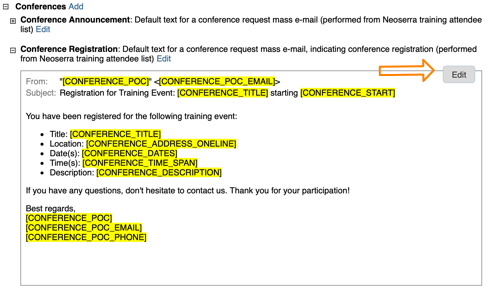
Note: As discussed in the following section, you can also include substitution variables in your email template. These variables are replaced at the time of email generation with data found in the Neoserra database. When updating addressing fields especially, it's likely that you'll want to take advantage of these substitution variables rather than using hard coded email addresses.
Using Substitution Variables
There are many instances when customizing email templates in which you will want to display information that varies depending upon the context of the message. A simple example is the email's salutation; it is more friendly to say "Dear Bob" or "Dear Mary" rather than generically address all clients. Similarly, you may want to add a QR code to your registration emails.
Neoserra allows you to use variable substitution by providing you with a list of variables available for insertion from the edit box. The complete list of available variables are shown on the right hand side of the screen. You can search for the variable that best suits your needs. Once you have identified the variable that you want to use, then edit your template and leave your cursor where you would like to insert the varibable. Next, click once on on the variable and it will be inserted into the current cursor location.
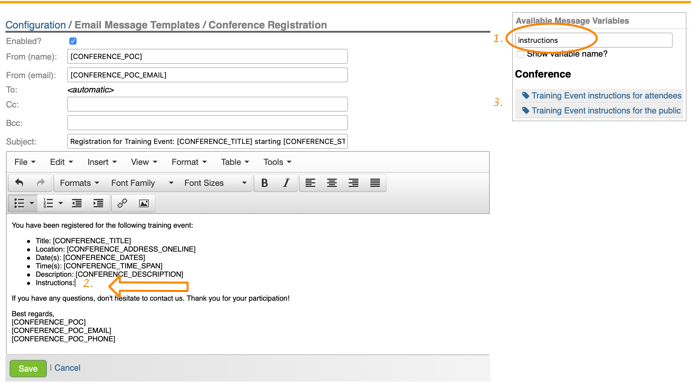
All email templates can include variables and, in view mode, they're easy to spot because they are surrounded by brackets. At the time of email generation, these substitution variables is automatically replaced with the relevant information stored in Neoserra. Because you may be sending a blast email to clients across multiple centers, it is important to realize that the email template used is always the template from the current center of the user. Furthermore, Neoserra will always use client variables as found on the client record; the contact variables as found on the contact record; and center variables as found on the center record of the user who is sending the email template.
Note: Do not remove the brackets around the variables or change their names. In order to use the variables correctly you must maintain their formatting.
We strongly recommend the use of substitution variables for you name, phone number and email address in the salutation. This will ensure that you don't have to update all your templates each time there is a change in your personal details. Instead you can just update your counselor and/or center record and your email templates will be instantly updated.
Note: If you are including eCenter Direct substitution variables in your templates, then it is essential that you have eCenter Direct deployed. Any substitution variable that cannot be resolved when the email message is sent, will be blank. In other words, if you use the [ECENTER_URL] variable, and you don't actually have eCenter Direct installed then this will appear as blank space in the email message that is sent out.
Important! Please be aware that you should NOT ever forward an email with the [HOME_ECENTER_URL_AUTOLOGIN] or [CONFERENCE_ECENTER_URL_AUTOLOGIN] variables from your own personal email application. These two variables will resolve to YOUR login to eCenter Direct. Forwarding a copy of this message to your clients will cause them to log in to your account. If this does happen, then it is important to revoke the token immediately, as discussed here.
Disabling Emails
If there are automated emails that you find unnecessary or pesky as you (or your clients) move throughout Neoserra and eCenter, you can disable them on a per-message basis simply by deselecting the Enabled? check box. As with the other edits described above, email messages can be disabled globally or on a per-center basis.
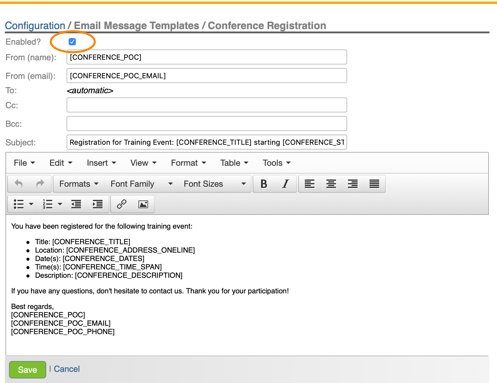
Adding Images
You can add an image to the email templates. For example, you might want to add your program's logo, or even some of the social media icons in your signature line. Probably, you will want users to be able click on this image and automatically go to the program's web site or go to your social media site. If this is the case, then the steps to insert these are as follows:
- Click to "Edit" the template to which you want to add your image.
- First, click the "Insert/edit Link" icon:
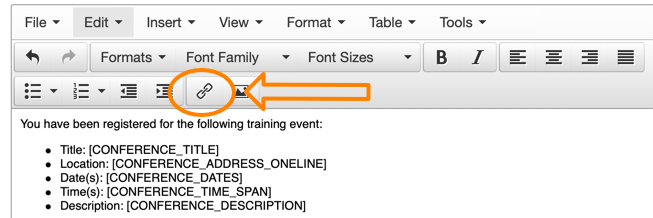
- This will allow you to enter the actual link that you want to direct the user to when they click on the image. You can ignore the second field and leave the default, because an image will be displayed, rather than the URL itself. In the target field, you can decide whether you want the user to open a new window for the link if/when they click on the image, or to use the existing window:
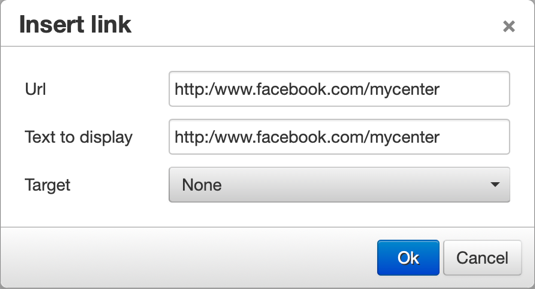
- Click "OK" to save, and your URL will be inserted in the template.
- Next, it is time to insert the image that you want to use. Highlight the URL, and then click on the "Insert/edit Image" icon:
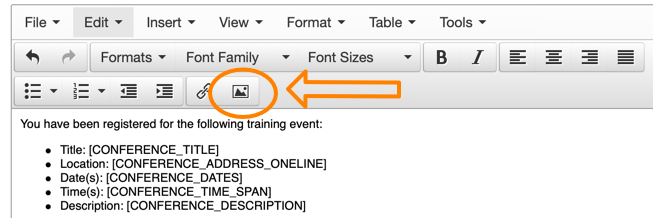
- Fill in the public URL where your image is located. The image needs to be accessible to anyone of the internet. You can enter a description for your image and then a size:
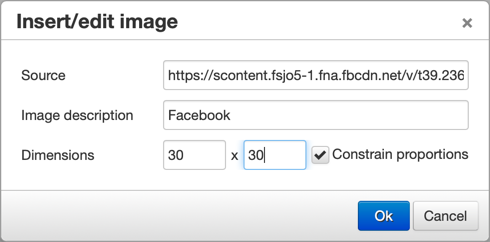
- Assuming that you did highlight the URL when you initiated the previous step, then the URL will be replaced with your image, which will be clicable to the URL previously entered:
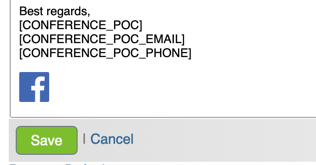
Creating User-Defined Templates
There are a variety of reasons why you may want to create a custom email template:
- If you have a standard email that you always send to customers after your first meeting;
- If you have a standard email that you always send to training attendees as follow-up to your event;
- If you have a specific email address that you want to send from (keep in mind that, by default, Neoserra will always send using the email address of the person who is logged in and who is initiating the email).
These are just some example of how you can use the custom template option in Neoserra.
Only system administrators will be able to create new custom templates, but once a template is created, any user can edit the template for their center, from the center record (assuming they have permissions to the center record.)
To create a new template, follow these steps:
- Enter administrator-mode.
- Click Administration|Configuration and select "Email Templates."
- Decide what type of email template you wish to create. Neoserra allows you to create custom templates for:
- Clients
- Conferences
- Contacts
- Counselors
- eCenter Client Signups
- Surveys
- Click "Add" next to the appropriate template type:
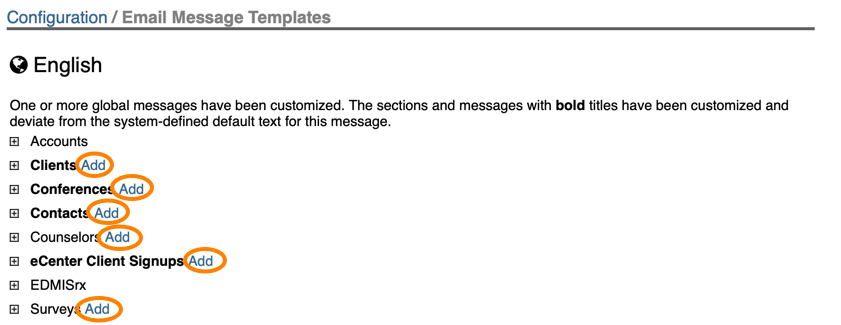
You will also notice that you cannot create custom eCenter templates. The reason for this restriction is because these templates are automatically invoked by Neoserra and eCenter Direct, and the automated processes would not know when to initiate your custom template vs. the built-in template. As such, you can only create new custom templates if the template can be selected by a human user.
- Clicking "Add" will open the template definition. Enter a template name and a short description to help remind you down the road the intended purpose of this template:
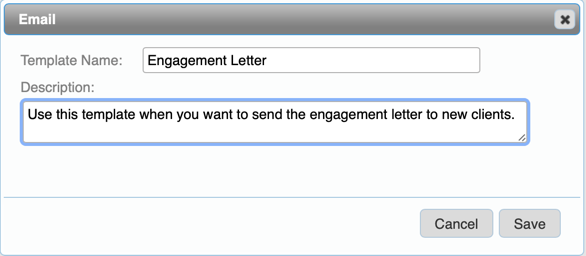
- Click Save and proceed to edit the text in your template. Neoserra will create a baseline template for you but you can edit it to your specific needs using substitution variables and adding images as noted above:
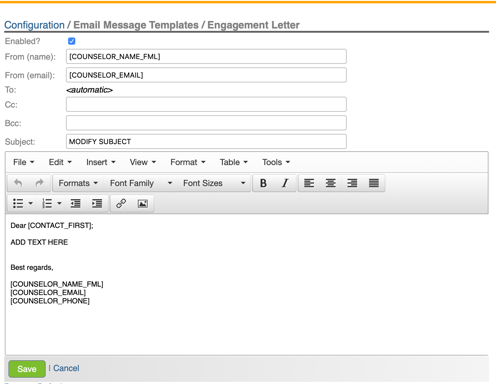
- Once you save your template, then it will be stored under the template type heading where you created it and you will be able to use it just like any other template under that heading:
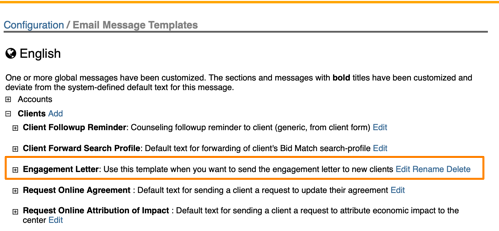
Custom templates can only be created by the administrator under the Administration|Configuration|Email Templates panel. However, once created, then all users with Center permissions will be able to see the newly created template under their respective Center's More|Email Templates menu option.
Want more? Browse our extensive list of Neoserra FAQs.
